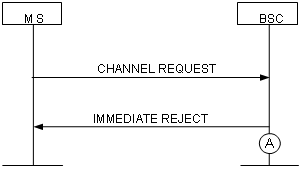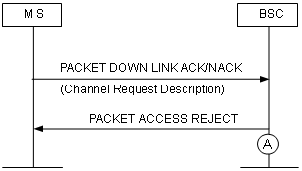Measurement Counter
A9016:UP_GPRS_TBF_ESTB_FAIL_OTHER_CAUSE
Description
This measurement provides the number of failed uplink GPRS TBF establishments due to other causes in a granularity period. A high measurement value is yielded because the channel assignment exception or failure occurs in the cell, or the uplink GPRS TBFs on the PDCHs reach the limit.
Unit
Integer number or integer.
Measurement Point
Failed uplink GPRS TBF establishment using one phase access due to other causes
After receiving the CHANNEL REQUEST message, the BSC sends an IMMEDIATE REJECT message on the CCCH to reject the access request from the MS if the uplink GPRS TBF cannot be established due to abnormal or failed resource allocation or flow control. If the uplink GPRS TBF cannot be established because the BSC detects overload protection on the board, the BSC does not send the channel assignment message. Figure 1 shows the procedure in which the BSC rejects the channel request from the MS. Each time the BSC sends an IMMEDIATE REJECT message (see measurement point A), the counter is incremented by one.
Figure 1 Failed uplink GPRS TBF establishment using one phase access due to no channel
Failed uplink GPRS TBF establishment using single block access due to other causes
During the single block access procedure or when the MS requests the change of radio resource configuration, the BSC receives the PACKET RESOURCE REQUEST message from the MS. This message requests the establishment or re-establishment of the uplink GPRS TBF. If the uplink GPRS TBF establishment fails due to abnormal or failed resource allocation or flow control, the BSC sends a PACKET ACCESS REJECT message on the PACCH to reject the access request from the MS. Figure 2 shows the procedure in which the BSC rejects the uplink resource request from the MS. Each time the BSC sends a PACKET ACCESS REJECT message (see measurement point A), the counter is incremented by one.
Figure 2 Failed uplink GPRS TBF establishment using single block access due to no channel
Failed uplink GPRS TBF establishment on the PACCH due to other causes
If the Channel Request information element in the PACKET DOWNLINK ACK/NACK received by the BSC from the MS indicates that the uplink GPRS TBF cannot be established due to abnormal or failed resource allocation or flow control, the BSC sends a PACKET ACCESS REJECT message on the PACCH to reject the access request from the MS. Figure 3 shows the procedure in which the BSC rejects the uplink packet channel request from the MS. Each time the BSC sends a PACKET ACCESS REJECT message (see measurement point A), the counter is incremented by one.
Figure 3 Failed uplink GPRS TBF establishment on the PACCH due to no channel
Formula
This is an original counter without involving any formula.